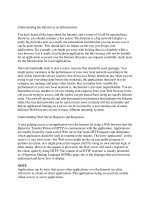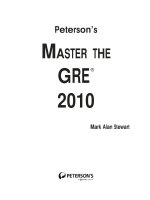Tài liệu Reinterpreting The Skill-biased Technological Change Hypothesis docx
Bạn đang xem bản rút gọn của tài liệu. Xem và tải ngay bản đầy đủ của tài liệu tại đây (221.32 KB, 43 trang )
Reinterpreting the Skill-
biased Technological
Change Hypothesis
A Study of Technology, Firm Size,
and Wage Inequality in the
California Hospital Industry
CASSANDRA M. GUARINO
WR-316
November 2005
WORKING
P A P E R
This product is part of the RAND
Labor and Population working
paper series. RAND working papers
are intended to share researchers’
latest findings and to solicit informal
peer review. They have been approved
for circulation by RAND Labor and
Population but have not been
formally edited or peer reviewed.
Unless otherwise indicated, working
papers can be quoted and cited
without permission of the author,
provided the source is clearly referred
to as a working paper. RAND’s
publications do not necessarily
reflect the opinions of its research
clients and sponsors.
is a registered trademark.
Abstract: This study examines data from the 1983-1993 California hospital
industry to test whether observed patterns of wage inequality growth can be explained by
the skill-biased technological change hypothesis. The study finds little evidence of a
direct link between technological inputs and skill premia, particularly when growth in
firm size is taken into account. The findings challenge the notion that technological
change is skill biased and suggest that economies of scale permit hospitals to compete for
clientele on the basis of labor force quality. Since technological expenditures often
promote consolidation, a reassessment of the relationship between wages and technology
is suggested.
2
The wage premia associated with higher levels of skill rose notably throughout
the 1980s and during particular periods in the 1990s. The college premium—the
percentage by which the earnings of college graduates exceed those of high school
graduates—rose from approximately 38 percent in 1979 to 73 percent in 1992, after
which it slowed through 1997, increased again in the last part of the decade to 78 percent
in 2001, and then leveled off somewhat.
1
Despite concern over increased inequality as a
potential cause of social tension (see, for example, Riscavage, 1995), controversy has
existed as to the underlying causes of the observed trends. Theories centering around
global trade (Borjas and Ramey, 1994), factor outsourcing (Feenstra and Hanson, 1996),
the weakening of labor unions (Mishel and Teixeira, 1991; Howell, 1994; Howell and
Wieler, 1998), the failure of legislatures to maintain the real value of the minimum wage
(DiNardo et al., 1996, Fortin and Lemieux, 1997), and influxes of low-skilled
immigration (Borjas, 1994) have been advanced, but the most widely espoused theory has
been that of skill-biased technological change (SBTC)—the notion that widespread
advances in technology have intensified the demand for more highly skilled workers
because these workers interact more productively than less skilled workers with
technological inputs (Autor, Katz, and Kreuger, 1998; Berman, Bound and Griliches,
1994; Kreuger, 1993; Katz and Murphy, 1992, Murphy and Welch, 1992).
The general acceptance of the SBTC hypothesis in the early and mid 1990s
created a preferential climate for policies promoting the acquisition of education and
training for the low-skilled
2
rather than policies to regulate trade and the use of foreign
1
Statistics were provided by the Bureau of Labor Statistics and based on median usual weekly
earnings of full-time wage and salary workers 25 years and older from the Current Population Survey.
2
See, for example, the School-to-work Opportunities Act of 1992.
3
labor, to shore up union power, or to restrict the entry of low-skilled workers into the
U.S. As the growth in the college premium slowed in the mid-1990s, education- and
training-related policies received less attention, but in light of more recent upturns, they
may regain popularity.
Studies testing the SBTC theory have produced mixed results. The early case in
support of the hypothesis was based primarily on the observation of concurrent trends at
the macro level (e.g., Katz and Murphy, 1992, Murphy and Welch, 1992), but subsequent
work attempted to link technology to wages within industries at the micro level.
Although within-industry studies may present an incomplete picture of the wage
determination process if the single industries under consideration are small actors within
the larger labor supply and demand context, the fact that wage inequality growth in the
1980s and 1990s was stronger within industries than across them and linked more heavily
to increases in the demand for skill rather than decreases in the supply (Autor, Katz, and
Krueger, 1998; Berman, Bound, and Machin, 1998; Katz and Murphy, 1992) suggests
that studies of firm-level wages and technology can offer valuable insights.
A few within-industry studies found a positive association between wages and
technological inputs, particularly those related to computers (Autor, Katz, and Kreuger,
1998; Krueger, 1993). Doms, Dunne, and Troske (1997), using longitudinal data,
however, found that high wages in technologically advanced firms were due to the high
skill level of their workers but that this skill level was unrelated to the adoption of new
technologies.
The research presented in this paper consists of a within-industry study that
carries the analysis one step further. The findings support the insights offered by Doms,
4
Dunne, and Troske (1997) and point to a possible explanation for the failure of
technology to connect directly with wages despite the concurrence of trends.
This study examines longitudinal hospital-level data collected in California
between 1983 and 1993 to determine if the wage and technology patterns observed in the
industry were consistent with SBTC. The hospital industry provides a convenient context
for this investigation for three reasons: 1) its wage inequality trends mirrored those of the
national economy in the 1980s and 1990s, 2) it experienced a substantial growth in
technology during the same time period, and 3) it is rich in the type of micro-level data
on wages and technology that are needed to support a thorough analysis. The study finds
little support for the SBTC hypothesis. Although the same prima facie association
between technological sophistication and skill premia evident in the national context is
also evident in the hospital industry, in-depth analysis challenges the notion that these
premia are the result of a comparative advantage of skilled workers with technological
inputs. The study raises questions about the traditional assertions of the SBTC
hypothesis and provides new information that might lead to a reinterpretation.
The analysis reported in the study carries some limitations. Like other within-
industry studies, it focuses on a subset of a larger labor market, and it takes a reduced-
form approach to a general equilibrium problem. Auxiliary analyses comparing hospital
and non-hospital wages suggest, however, that the restricted focus does not present a
large problem for the validity of the findings, and although reduced-form models cannot
strictly test the SBTC hypotheses, they reveal associations that cast doubt on its
credibility.
5
Conceptual Framework
This section outlines the conceptual structure used to analyze hospital-level
behavior regarding the compensation of high- and low-skilled labor. It assumes, in
accordance with the neoclassical model of labor supply and demand, that wages for a
particular category of labor (i.e., a skill or occupation group) are determined by the
interaction of supply factors (e.g., the education and other pertinent characteristics of the
labor pool, as well as the alternative opportunities available) and demand factors (e.g., the
prices of outputs and all relevant inputs that affect the marginal product of labor) in a
given labor market and that, within the context of its own particular market, a hospital
takes the equilibrium wage as exogenous. The hospital then determines its own demand
for labor following the framework outlined below, which extends the classical model of
labor demand to conform to the realities of hospital production.
The hospital maximizes a preference function that includes profits and other
variables, such as the quality of patient care, charity, status, or teaching (Newhouse,
1970; Lee, 1971) and produces more than one type of output—e.g., heart transplants,
neonatal care, etc. In addition, hospitals utilize many types of labor inputs, such as
registered nurses, technicians, nursing assistants, etc., as well as many types of capital
inputs, such as X-ray machines, CT scanners, and blood pressure monitors. Therefore,
subject to constraints on production technologies and the availability of specific inputs,
one can say that hospital decision makers maximize utility according to the following
specification in which profit and the other arguments are functions of the outputs, inputs,
and prices:
),( otherUUtilityȂax
S
6
),(),(),( M1m
k
J1j
l
I1i
y
trw
mj
i
K
k
L
lkkll
fy
ts
m
m
j
jm1j1
ii
),,,,( dd
where represents the production function for the
ith output y and and represent
external limits on the supply of labor
l
and capital .
f
i
L
j
K
m
j
k
m
From the utility maximization process emerge the output supply functions
y
i
and factor demand functions and
l
j
k
m
, which are functions of prices, wages, and
rents. It is expected that there will be variation in utility functions across hospitals,
according to the degree to which factors other than profit are being maximized or the
degree to which different types of outputs are being produced. In theory, a set of
modified or reduced-form labor demand equations could be derived by substituting
prices, wages, and rents with functions expressed in terms of output and capital choices to
obtain equations of the form:
),,
,,
,,,(
ww
k
k
yyg
l
j1
1
m
I1j
j
These modified labor demand equations incorporate direct links between labor
usage and technology inputs in the form of physical capital.
Each
l
represents a particular type of hospital employee. As a first approach,
one might consider each to represent a different health care occupation. For example,
might be the chosen quantity of hours of employment of hospital administrators,
j
l
j
l
1
l
2
might be the chosen quantity of registered staff nurses, and so on. It is assumed that
hospitals take as exogenous the wages assigned to various occupational categories by the
7
interaction of supply and demand in their own geographically circumscribed labor
markets, although this assumption is subject to controversy.
3
Since the chosen proportions of workers in different occupational categories are
observable, this occupation-based approach to defining the various provides one with a
framework within which the modified labor demand functions—
g(.)—might be estimated
to provide a measure of the association between technological input choices and the
chosen number of hours of employment of particular occupation. Since some
occupations require a higher degree of skill than others, one could draw some broad
inferences regarding the relationship of technology to the demand for skill by observing
the employment of high-skilled occupations relative to the employment of others.
l
j
A simplistic approach to testing the SBTC hypothesis might therefore involve
checking for a positive association between some measure of technology and some
measure of relative employment—the ratio of high-skilled to low-skilled full-time-
equivalent employees (FTE), for example—within hospitals. A first hypothesis might
therefore be the following:
H1) technological sophistication will be positively associated with the relative
employment of high-skilled categories of labor.
A problem with this approach is that technologically advanced hospitals might
plausibly seek to employ high levels of skill
within both their high- and low-skilled
3
Yett (1975) and Sullivan (1989) asserted that monopsony power existed in hospital labor
markets. This assertion was challenged by Hansen (1991, 1992) who found no evidence of monopsony
behavior. Robinson (1988a, 1988b) found evidence that hospitals in more competitive markets paid higher
wages than those in less competitive markets, a finding consistent with monopsony theory. After
controlling for supply difference, however, he finds that more competitive markets are also characterized
by higher vacancy rates. The monopsony hypothesis, he claims, would predict the opposite, i.e., higher
vacancy rates in less competitive markets, due to the fact that hospitals in these markets refuse collusively
to raise wage rates. He therefore attributes higher wages in more competitive markets to non-price (i.e.,
quality-based) competition. In this model, I assume that higher wages represent a higher quality workforce.
8
occupational groups. If enough variation in skill level exists among workers within both
groups, then a true positive association between technology and skill might fail to
translate into a positive association between technology and relative employment.
Average Wage as a Proxy for Skill
A different approach to assigning meaning to the labor inputs l, and one that can
better tease out the true association of technology with skill, would be to consider the
l to
represent
skill rather than occupation categories. While occupational categories provide a
rough measure of skill, heterogeneity of skill can occur within occupations, arising from
differences in the education, training, experience, or ability of workers. The number of
“skill categories” employed in a hospital may therefore far exceed the number of
occupational categories. Differences across hospitals in the average skill level within an
occupation category are not generally observable, but if they were, one could, in theory,
relate these skill-based
choices directly to capital input choices, by estimating the
modified labor demand functions in the same manner as before.
l
n
A reasonable proxy for skill exists in the form of the average wage, however.
Since a highly skilled registered nurse, for example, might command a higher wage than
a less-skilled registered nurse because she or he may have a larger set of relevant
alternatives or be in greater demand, a relatively high average wage for nurses in a
particular hospital, after adjusting for cost of living and market supply tightness, would
indicate a highly skilled nursing staff.
4
Using the hypothetical set of labor demand
functions relating to each generic skill category, one can construct average wage
4
It commonplace for nurses and aides, for example, to be assigned to categories based on
education and experience and for their wages to be differentiated accordingly.
9
functions aw
j
for each of the J occupational categories.
5
The effect of technology on the
average wage is the derivative
w
aw/
w
t. If one assumes that hospitals paying a higher
wage to workers in a particular occupation category are obtaining higher levels of skill
within the category, it can be inferred that if the average wage of an occupation category
increases with respect to technology, then the proportion of high- to low-skilled workers
within that occupation increases with respect to technology, i.e., that technology and skill
act as complements rather than substitutes.
Under this framework built upon modified
occupation- and skill-based factor
demands, it is therefore possible to determine the strength of the association of
technology to relative wages, taking into account the entire picture, including across- and
within-category heterogeneity. If the SBTC hypothesis is true, then one would expect to
find a positive association between technology and the wages it pays to each category of
workers—particularly those who are highly skilled. The following prediction should
hold:
H2) technological sophistication will be positively associated with within-
category average wages, particularly for high-skilled categories of labor.
In addition, if high- rather than low-skilled worker wages are primarily affected
by the presence of sophisticated technologies, then a further hypothesis might be:
5
The equation for each category would be:
other)(t,l
other)(t,
l
*
w
=
aw
n
N
=1n
nn
N
=1n
j
¦
¦
where N is the number of skill categories within the jth occupational category, and the skill categories l are
functions of technology t and other variables.
10
H3) higher levels of technological sophistication will be associated with higher
relative wages (in the form of the ratio of high- to low-skilled wages, for example) within
hospitals.
Data
The data used in this study were drawn primarily from the California Office of
Statewide Health Planning and Development (OSHPD) annual surveys of hospitals.
6
California hospitals are required to submit two types of reports to OSHPD on an annual
basis: 1) the Annual Disclosure Reports, which provide a wealth of detail regarding the
characteristics and financial activities of each hospital, including information pertaining
to the use of specific technologies and the hourly wages and hours of employment of
different categories of labor, and 2) the Annual Patient Discharge Reports, which provide
information regarding patient characteristics and revenue sources.
Of the different types of hospitals in California, I selected the subset of short-term
general acute-care hospitals—approximately 80 percent of all hospitals—in order to
obtain a sample of only those organizations for which it would be feasible or desirable to
utilize similar technologies.
7
The period under consideration was limited to the span of
years from 1983 to 1993, years that saw the beginning and end of a continuous increase
in the wage gap between high- and low-skilled workers. The total number of
observations in the panel composed of short-term general hospitals across the eleven
years under consideration was 4,572. The number of these hospitals in California varied
6
Data from the Current Population Survey (CPS) were also used to supplement some of the
descriptive analyses. Sample weights were used in all calculations involving CPS data and wages were
deflated to 1983 levels by the Consumer Price Index.
7
Kaiser hospitals were also eliminated because OSHPD grants them a reporting exemption with
respect to wages, and their wage data were therefore incomplete. Kaiser hospitals represented
approximately five percent of the hospitals in California in 1993.
11
from 450 in 1983 to 384 in 1993, due to the fact that many hospitals closed or merged
with others during the period under consideration. Sixty-nine percent of the hospitals in
the sample were in operation in all eleven years. The total number of unique hospitals
was 479; therefore, despite the general trend towards hospital attrition and consolidation,
there were also some hospitals that came into operation during the period under
consideration.
The Measurement of Employment and Wages
The OSHPD annual disclosure reporting forms ask hospitals to report the average
hourly wages and hours worked of ten different categories of hospital workers within
each unit of the hospital, with six of these representing approximately 98 percent of the
hospital labor force. The six categories are 1) management and supervision (consisting of
head nurses and hospital administrators), 2) technicians and specialists, 3) registered staff
nurses, 4) licensed vocational or practical nurses, 5) aides and orderlies, and 6) clerical
and administrative workers.
8
I included only the first five categories in my analysis,
because they represented the largest groups of hospital workers with direct responsibility
for patient care and because the technological inputs examined in this study were patient-
care technologies. The unit-level data on wages and hours worked were aggregated to
hospital-level hours and average wages for each of the five occupational groups for each
hospital in each year. The wages were then deflated to 1983 levels by the Consumer
Price Index to obtain real wages.
9
8
The other categories are 7) environmental and food service specialists, 8) physicians, such as
resident housestaff, 9) non-physician medical practitioners, such as physicians’ assistants and nurse
practitioners, and 10) other workers. Data on hospital-based physicians and non-physician practitioners
were sparse and unevenly distributed.
9
In addition, because California hospitals are required to submit the annual disclosure report at the
end of their fiscal year and the fiscal year end varies from hospital to hospital, it was problematic to
12
From these five categories, two larger labor categories—one composed of highly
skilled workers and the other composed of mid-to-low-skilled workers—were created.
Using education as a metric for skill (see Table 1), I placed management and supervision,
technicians and specialists, and registered nurses—who possessed on average 15 years of
schooling—in the high-skill category and placed licensed vocational nurses and aides—
who possessed on average 12 to 13 years of schooling—in the low-skill category.
Average wages and hours worked for each of the two aggregate categories in each
hospital and year were then calculated.
10
The Measurement of Technology
A challenge faced by researchers who attempt to link technology to wages is to
find a meaningful way to quantify technology. Since technology is embedded in capital
and is not composed of homogeneous units that remain equally useful throughout time,
the task is far from straightforward. As time passes, some technological services become
less costly, less useful, or obsolete, and, at any given time, some types of services are
more sophisticated than others. Many organizations—hospitals, in particular—use more
than one type of technology in their production process, and the relative importance of
these types must be weighed in assessing the organization’s overall technological
sophistication.
The characterization of technology for analytic purposes is further complicated by
the fact that certain technologies are substitutes for skill while others are complements.
compare data across hospitals that reported at different points in time. To resolve this problem, estimates
of the values that would have been reported had the fiscal year end been the 31
st
of December of each year
for every hospital were created using linear interpolation methods. Since approximately one quarter of the
observations had a fiscal year end of December 31
st
, estimates were used in approximately three quarters of
the observations.
10
Average wages appeared unrealistically high in 22 observations and were set to missing.
13
The difficulty of separating technologies of one sort from the other can obscure the
mechanism by which technology might affect wages (Levin and Rumberger, 1989).
Bartel and Lichtenberg (1987) hypothesized that the demand for skilled labor rises when
technologies are first introduced into the productive process. They reasoned that skilled
workers posses a comparative advantage with respect to unfamiliar technological inputs
in that they are better able to adjust to and implement new techniques. Once diffused,
they claim, a technology can be successfully and more cheaply operated by less educated
workers and used as a substitute for skill. According to this theory, new technology
initially increases the demand for skilled labor but later reduces it. The degree to which
new technologies are skill-saving or skill-using may also depend upon contextual factors,
such as the labor supply in the long term. Acemoglu (1998) theorized that the
complementarity of technology is endogenous to the labor supply. If a large pool of
skilled labor exists, the types of technology that will be utilized or invented will be those
that are complementary to skill and vice-versa.
Not only the presence of technological inputs in a hospital, therefore, but also the
particular features of those inputs are important in assessing their effect on skill-based
wage gaps. An ideal technology measure would capture all of the relevant features—
type, amount, newness, and skill complementarity. The data available specify the
number and type of technologies possessed by hospitals but do not, however, directly
indicate the degree to which these technologies are complementary to skill. The approach
to technology measurement used in this study was to construct an index that captured the
sophistication of the technological inputs present in a hospital by estimating the degree to
which the hospital’s technologies are relatively rare at a given point in time.
14
The index was created as follows. The OSHPD annual disclosure reports contain
a list of the possible technical inputs that a hospital might utilize. Every hospital is asked
to report whether or not it utilizes each type of input. In consultation with physicians, a
subset of 85 technologies that reflected the machine-intensive, patient care-related
technological capabilities of a hospital was drawn. Each observation in the dataset
represented a hospital year, and for each technological input, a value of 1 was assigned if
it was present in the hospital in that year and a value of 0 was assigned if it was absent.
The second step in creating the measure consisted of weighting the different
technological capacities possessed by a hospital by an indicator of the degree to which
they were rare. The weights were created by taking the mean value for each input across
all hospitals in a given year and subtracting each mean from the number “1” to get the
proportion of hospitals that did not use the input. Each weight, therefore, represented the
degree to which the input was rare in a particular year. For each hospital in each year, the
value of every service (0 or 1) was then multiplied by its year-specific weight. A list of
the 85 selected inputs that a hospital might offer and the calculation of their “rareness” in
the year 1983 is shown in Appendix 1.
The third and final step in creating the index,
11
was to average the products of
inputs and weights for each hospital in each year in order to remove any unintended
correlation with the size of the hospital. Thus, a small hospital that specialized in “high
tech” services, such as cardiac care, could receive as high a score on the index as a large
hospital with a similar spectrum of sophisticated technology.
11
This index represents a modification of the Saidin index introduced by Spetz in her doctoral
dissertation (1995) and named after the person who originated the idea.
15
Thus the index captured the technological sophistication of a hospital relative to
other hospitals at a given point in time, based on the degree to which its technological
services were rare. The initial selection of technologies, the weighting by rarity, and the
averaging of the weights ensured that hospitals that invested in new technologies received
higher values on the index than those that did not.
Control Variables
The empirical model expands upon the versions of the modified labor demand and
average wage functions outlined in the conceptual framework by inserting control
variables for hospital characteristics thought to predict different tradeoffs between profits
and other factors, such as quality. Hospital level fixed effects account for differences in
ownership status (i.e., whether the hospital was for-profit, nonprofit, religious, public,
etc.) and union status, which was relatively stable during the 1983-1993 period.
12
It was important to control for trends in the hospital industry that might affect
wages. The industry experienced negative price shocks and increased competition in the
1980s, due to changes in domestic policy.
13
In response, hospitals tended to restructure
their mix of both outputs and inputs. Changes in government financing parameters and
an increasingly competitive economic environment caused hospitals to decrease the
average length of a patient's stay during the 1980s, thus increasing the acuity level of the
average hospital patient (Anderson and Wootton, 1991). Spetz (1995) reported that the
12
Unions representing high-skilled workers in California hospitals remained in the 20-25 percent
range, and unions representing low-skilled workers remained in the 18-19 percent range between 1983 and
1993, according to survey data collected by the author.
13
A payment scheme aimed at containing hospital care costs, known as the Prospective Payment
System (PPS), was instituted by the federal government in 1983. It changed the method by which hospitals
were reimbursed for treating Medicare patients. Under the PPS system, hospitals receive a diagnosis-
specific lump sum for the treatment of each patient rather than reimbursement for the actual services
provided.
16
number of registered nurses rose during this period while the number of practical nurses
declined, as the need for medical expertise outweighed the need for simple bedside care.
However, Aiken and Gwyther (1995) found evidence that hospitals began shifting to a
work regime in which registered nurses were employed in smaller numbers as leaders of
teams composed of less expensive practical nurses and assistants in the mid 1990s.
Possible causes of these trends are accounted for in the empirical model by the inclusion
of variables relating to patient acuity levels (casemix), the length of stay of the average
patient, and patient revenue sources (i.e., the proportions of HMO and low-paying
patients). Market competition was accounted for by the number of hospitals in the same
health care finance planning area.
14
Indicator variables for each year of the panel were
used to control for the pure effect of business cycle fluctuations, exogenous price shocks,
and overall macroeconomic trends in the supply of labor, such as the percentage of
immigrant workers entering the health professions, trends in the numbers of nursing
graduates, etc., that would be expected to affect all regions in the state more or less
equally over the time period under consideration.
I also included the number of full-time equivalent employees, in logged form, to
represent the size of a hospital. The theoretical basis for a size-wage effect—the “scale
of operations” effect (Sattinger, 1993)—stems from the notion that a firm’s size
influences its ability to specialize and exploit the comparative advantage of different
types of labor inputs with technological inputs. Because size and technological
sophistication were highly correlated, the inclusion of a size measure subjected the SBTC
14
The Health Care Financing Administration (HCFA) defined boundaries separating areas in
which the health care institutions enclosed within them are thought to serve more or less the same
geographical population.
17
hypothesis to a stronger test than would otherwise have been possible.
15
A list of the
variables used in the analysis, along with their means and standard deviations, is
presented in Appendix 2.
Empirical Model
Descriptive analyses are first presented to set the context. Next, three sets of
regression models are used to relate technology to employment and wages in a manner
that takes into account the influence of several additional factors. The models consist of
reduced-form equations
16
that estimate the conditional expectations of relative
employment, high- and low-skilled wages, and relative wages, given values of the
technology index and other variables considered to influence these choices. I used
logarithmic forms of four dependent variables: 1) the log of the ratio of high-skilled
FTE
17
to low-skilled FTE, i.e., relative employment, 2) the log of high-skilled real wages,
3) the log of low-skilled real wages, and 4) the log of the ratio of high- to low-skilled real
wages, i.e., relative wages.
The first set of regressions estimates the change in the dependent variable
between 1983 and 1993 as a function of the change in the relative technological
sophistication of the hospital and other time-varying factors. The basic model for these
difference regressions is as follows:
'
y
i
=
J'
TI
i
+
'
X
i
E
+
H
i
(Model 1)
where
'
y
i
is the 1993-1983 difference in the dependent variable of interest for hospital i,
'
TI
i
is the difference in the technology index, and
'
X
i
represents a vector of differenced
15
The correlation between size and the technology index was .78.
16
If wages are taken as exogenous, then the empirical model estimates equations that are derived
directly from the structural labor demand equations.
17
FTE measures full-time equivalent personnel.
18
time-varying control variables relating to hospital characteristics. The coefficient
J
would be expected to be positive and significant to support the hypotheses stated in the
conceptual framework.
In order to take advantage of the entire panel of data and to obtain more detail
regarding the relationships under study, a second set of regressions is utilized. The basic
model for the second set is as follows:
y
it
=
D
i
+
O
t
+
J
TI
it
+ X
it
E
+
H
it
(Model 2)
where
D
and
O
are hospital and year fixed effects, TI is the technology index, and X is a
vector of time-varying control variables relating to hospital characteristics. A positive
and significant
J
would provide evidence in favor of the SBTC hypothesis.
The third set of regression models—Model 3—consisted of Model 2 augmented
to include interactions for all time-varying variables with the year indicators. In these
regressions, the sum of the coefficients on technology and other covariates with the
coefficients on the interaction terms—the “derivative” of the dependent variable with
respect to each covariate in year
t—was examined for sign and significance in each year
and for changes over time. Changes over time in the derivatives relating to technology
should be positive and significant if the hypotheses relating to SBTC are true.
Given the potential for bias in longitudinal models,
18
I checked for the presence of
autocorrelation within hospitals panels. Regressions of residuals on their lags suggested
that serial correlation was strong in the model, despite the inclusion of hospital-level
fixed effects, and that the error followed a first-order autoregressive process
18
See MaCurdy (1982).
19
)(
1
v
ȡİ
İ
it
it
it
. I therefore estimated a generalized linear model that specified an
AR(1) error structure.
Findings
Descriptive Analyses
A plot of mean wages over time shows clearly that wage inequality between high-
and low-skilled hospital occupations increased between 1983 and 1993 (see Figure 1a).
Real high-skilled wages grew steadily, especially in the late 1980s, while real low-skilled
wages remained at more or less the same level throughout.
Plots of total industry employment levels over time show that the employment of
high-skilled workers was roughly double that of low-skill workers in 1983, rose steadily
throughout the 1980s, and declined in the early 1990s (see Figure 1b). The employment
of low-skilled workers fluctuated only slightly.
In order to get a sense of changes in the distributions of wages during the time
period, I generated histograms of high- and low-skilled wages for 1983 and 1993 (see
Figure 2). The changes are dramatic. The high-skilled wage distribution experienced a
noticeable rightward shift and a definite widening over the ten-year period, while the
low-skilled distribution shifted and widened only slightly.
The growth in both the wages and employment of high-skilled workers suggests
that the demand for these workers shifted outward. The shift towards greater dispersion
among high-skilled workers indicates that heterogeneity due either to skill level or to
characteristics of the work environment played a greater role in their wage determination
at the end of the period than at the beginning.
Table 2 compares the rate of growth in real wages between 1983 and 1993 for
California hospital workers, calculated using the OSHPD data, to the same growth rates
20
for working women in the State of California, calculated using data from the Current
Population Survey (CPS). The purpose of this comparison is to obtain a sense of the
degree to which hospital worker wages appear to follow outside—or non-hospital
industry—wage trends.
The first part of the table displays the real hourly wages
19
and the change in these
wages over time of four categories of California women.
20
The four categories are based
on the educational level of the women and are the following: high school dropouts, high
school graduates, workers who had obtained some but less than four years of college, and
workers with four or more years of college. The second part of the table displays the
wages and growth rates of high-skilled and low-skilled hospital workers. Recall from
Table 1 that low-skilled hospital workers had approximately 12-13 years of schooling and
were thus comparable to groups 2 and 3 of the California female workers. High-skilled
hospital workers possessed an average of 14-15 years of schooling and were thus
comparable to groups 3 and 4 of the California females. As can be seen from the table,
low-skilled hospital workers experienced about the same gains as California females in
their comparison groups, whereas high-skilled hospital workers enjoyed higher real wage
gains than did the workers in their comparison groups.
The third part of Table 2 takes the comparison one step further. I divided
hospitals into three groups of equal number based upon their level of technological
sophistication as evidenced by the technology index. I then took average wages for high-
and low-skilled workers in hospitals within each third of the technology distribution.
19
These were calculated by dividing real weekly earnings by real weekly hours.
20
The vast majority of hospital workers are female (see Table 1), therefore female workers are the
appropriate comparison group.
21
Average wages within the low and high technology hospitals are reported here.
21
As can
be seen, high-skilled workers in high technology hospitals experienced the highest
growth rates of all hospital and California worker categories.
From this analysis, it appears unlikely that labor market trends outside the
hospital industry exerted a powerful influence on internal wage trends. Furthermore, the
variation in technological sophistication among hospitals appears to be a plausible
candidate in the search for factors contributing to the widening of the high-skilled wage
distribution. This notion is reinforced by simple correlations of the technology index with
the four outcome variables: 0.40 for the relative FTE measure, 0.35 for the high-skilled
wage measure, 0.26 for the low-skilled wage measure, and 0.02 for the relative wage
measure. The first three correlations were significant at the 1 percent level, and the last at
the 10 percent level.
Regression Findings
Multivariate analyses erased the evidence in favor of a technology effect,
however. Regression findings for Model 1—the difference model—provided no
evidence of support for the SBTC hypotheses. Table 3 shows the estimated coefficients
and t-statistics for the variables in these regressions. A change in hospital size is related
to a change in relative employment, and changes in the percentages of low-paying and
HMO patients were related to changes in the relative wage, but no associations with
technological sophistication were evident.
Regression findings for Models 2 and 3 are presented in Tables 4 and 5. To
facilitate the inspection of trends in the effects of the technology index and other
21
Those in the middle range of technological sophistication are left out.
22
covariate, Table 5 shows the sums of the main and interaction effects for these variables
for each year—i.e., the “derivative—and the p-values of tests of significance of each
sum.”
22
The technology index showed no significant relationship to any of the dependent
variables in the Model 2 and Model 3 regressions, with the exception of a negative and
significant main effect in the high-skilled wage regression in the interacted model.
Table 6 shows the results of a test aimed at identifying beginning to end of period
changes. It lists the p-values for a test of the significance of the difference between the
average of the first four and last four derivatives for the set of effects related to each
time-varying variable.
23
The technology index showed a significant change in its
association with only the low-skilled wage, a finding that does not help explain the
overall wage inequality trends in the industry. The effect of the size of the hospital,
however, represented by the log of total FTE, showed a positive and significant change in
association with every dependent variable. The size variable, though negative in most
cases, demonstrated a nearly monotonic upward trend in every regression and became
positively associated with relative wages during the period.
Sensitivity analyses, in which slightly different models were estimated,
24
produced no notable differences in the patterns reported above.
22
Full regression results are available from the author upon request.
23
For example, for the technology index, the test examined the significance of the sum of the
coefficients on the first four technology-year interactions minus the sum of the last four technology-year
interactions (dividing each sum by “4” to obtain the average was unnecessary).
24
Technology-size interactions were included in one model. Another specification included a
measure of occupational mix—i.e., the log of the ratio of high- to low-skilled FTE—on the right hand side
of the wage regression to control for the possibility that hospitals with similar average wages might differ
in important aspects of their work regime. Another specification used an IV model in which the share of
medicare patients was used as an instrument, given that the proportion of elderly patients might potentially
affect the demand for technology and, through this, the demand for skill. The instrument was not very
powerful, however, and the small coefficient in the first stage led to implausibly large coefficients on the
predicted technology variable in the second stage, although they were not significant and tended to be in
23
Discussion
The regression results revealed that the size of a hospital was more clearly
associated with skill than technological sophistication. Although size and technological
sophistication were highly correlated, the separation of the two effects via regression
analysis showed that the size of a hospital was associated with wage inequality growth in
a manner that was independent of investment in new technological equipment. Various
interpretations could be offered to explain this phenomenon. The literature regarding
size-wage premia offers limited insight, however, given that the size effect found here is
negative and few prior studies address changes in this effect over time. The hypothesis
that the premium reflects capital-skill complementarity (e.g., Griliches, 1969; Reilly,
1995) does not consider the effect of size independent of technological sophistication.
Other hypotheses relating to trade-offs between wages and the cost of monitoring (Bulow
and Summers, 1986) or the quality of management (Oi, 1983) might account for the
findings, if it could be established that these issues became increasingly important to
administrators of large hospitals over time. The hypothesis that the size-wage premium
would be higher in the absence of high-skilled workers matching themselves to smaller
firms (Idson and Feaster, 1990) might offer another explanation, if mergers offered
workers fewer small firms to choose from. Hospital mergers were frequent in the decade
under consideration. Building upon the concept of the influence of mergers, another
possible interpretation is that the economies of scale that a hospital realized when it
increases capacity may have been used to increase the quality of its staff in order to
compete on a non-price basis for patients (Robinson, 1988a, 1988b). The fact that the
the negative direction. Therefore the IV results are not presented here, although they provided no evidence
to contradict the reported results.
24
size coefficients changed from positive to negative over time in the relative wage
regressions might indicate that administrators in large hospitals perceived a particular
benefit to hiring high-quality high-skilled workers and considered low skilled workers to
be somewhat more generic.
If economies of scale were a factor driving the association of size and wage
inequality in this manner, then perhaps the SBTC hypothesis can be reinterpreted. The
results of the regression analyses presented in the previous section do not support a
traditional interpretation of the hypothesis—i.e., that the presence of advanced
technology in a hospital requires workers with greater skill to operate the equipment due
to their comparative advantage with respect to technological inputs. Yet, it is plausible
that the perceived need to acquire sophisticated and expensive technologies was a factor
in promoting mergers and consolidation in the hospital industry in the 1980s and 1990s.
Furthermore, the OSHPD data reveal that while overall patient days declined by 23
percent between 1983 and 1993,
25
the average size of a hospital, in terms of the number
of FTE in the five categories of employment under consideration in this study, grew by 9
percent during the same period. If technology prices were one of a number of factors
bringing about mergers and most of those newly formed large institutions decided to use
their new-found economies of scale to compete for patients on the basis of quality, then
the association of size with wages would be primary and the association of technology
with wages would be secondary.
25
This was due to the decrease in the average length of a patient’s stay in the hospital.
25









